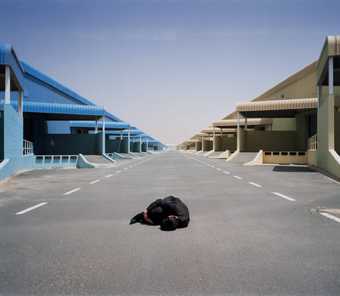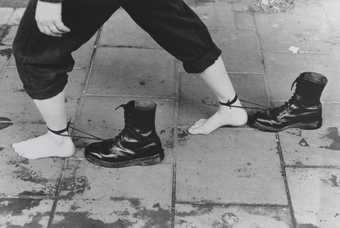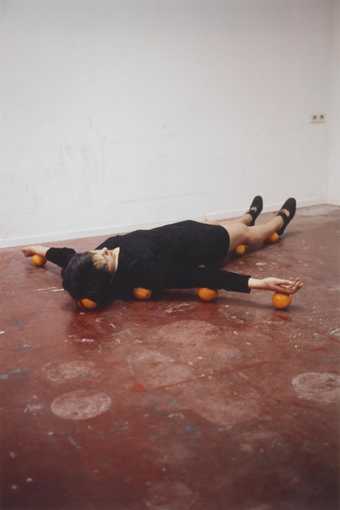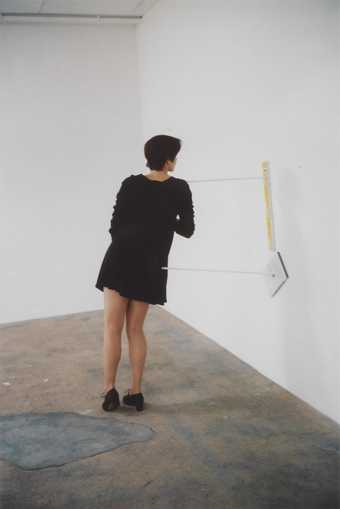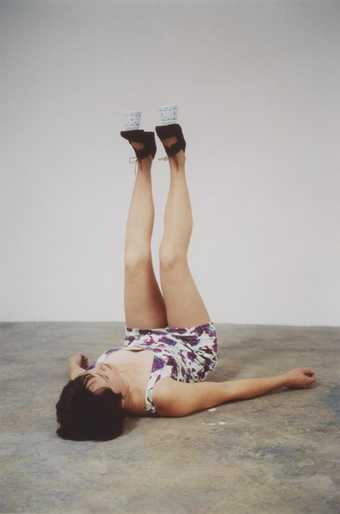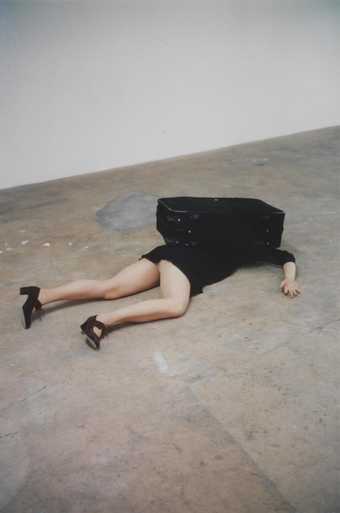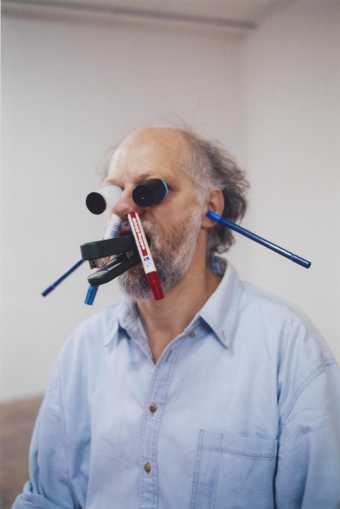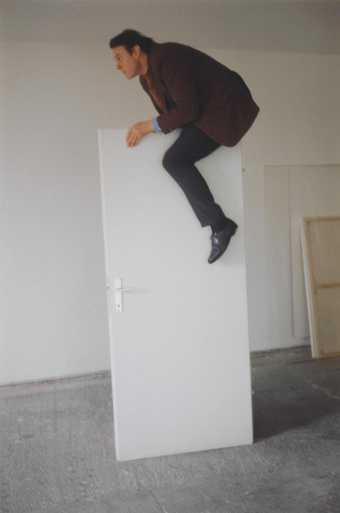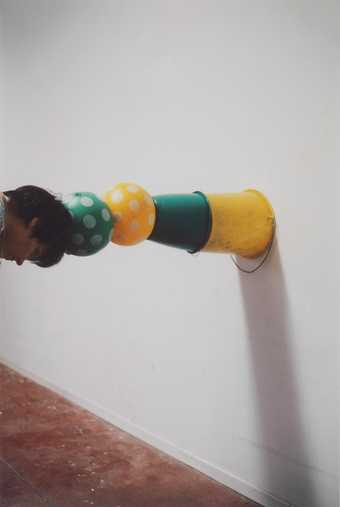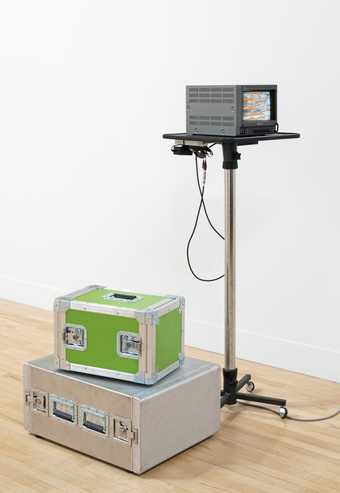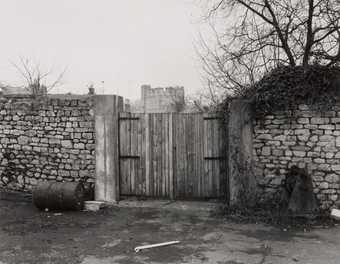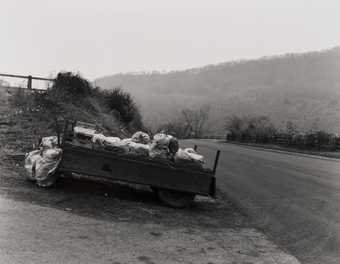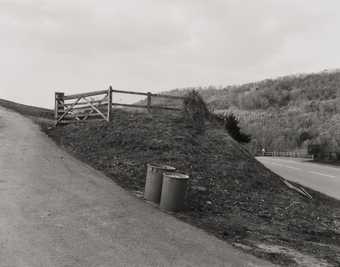
Not on display
- Artist
- Erwin Wurm born 1954
- Part of
- One Minute Sculptures
- Medium
- Photograph, c-print on paper
- Dimensions
- Support: 450 × 300 mm
- Collection
- Tate
- Acquisition
- Purchased from the artist with funds provided by Hyundai Card 2017
- Reference
- P82013
Summary
This colour photograph is one of a large number in Tate’s collection from Erwin Wurm’s series One Minute Sculptures (see Tate P14777–P14816 and Tate P82011–P82018). Wurm began his One Minute Sculptures in 1988, and has since been continuously contributing to the encyclopaedic series in myriad locations around the world. As well as photographs, the series comprises video (see One Minute Sculptures 1977, Tate T15047) and performance works (see Double Bucket 2009, Tate T15258, and Organisation of Love 2007, Tate T15257). The individual photographs feature images of people – anonymous participants, performers, curators, artists and even the artist himself – engaging in unconventional and sometimes physically challenging interactions with everyday objects such as clothing, buckets, balls, doorframes, bicycles and perishable goods. The resulting compositions feature unusual contortions – held for a minute – and illogical still-lives that are both humorous and provocative. While the photograph is the enduring record of each composition, the work comprises the entirety of the performative process, which begins with Wurm delivering instructions, both written and pictorial, to the subject of the ‘sculpture’. The participant subsequently enacts the determined formation or action and maintains it for a period of sixty seconds, during which time the pose is photographed. In a complex work that explores interaction, activation and the temporal, Wurm employs the photographic medium as a means of cataloguing his ephemeral studies.
While the unexpected combinations intentionally register as absurd upon first glance, the One Minute Sculptures offer a contemplative exploration of the parameters of the act of image-making. The multi-layered series spans the range of media central to Wurm’s practice performance, sculpture and photography) and seeks to blur the distinction of one from the other. They are exercises in which the artist investigates what he has described as the basic qualities of sculpture, such as volume, space and the possibility of interaction with the viewer. Wurm challenges not only the physical relationship between human and object with unconventional pairings, but also the individual and societal perception of self and one’s surroundings. Historian Stephen Berg has described the treatment of the body and self in Wurm’s work, stating that ‘The more that is poked into its orifices, and the more food and clothing that is accumulated around it, the clearer it becomes that the body and the self are no longer masters in their own house, and as a result achieve self-expression more through self-deformation.’ (Stephen Berg, ‘The Ridiculous Human Tragedy’, translated by Michael Turnbull, in Berg 2009, p.48.)
This notion of deformation, or distortion, lends a deconstructive element to the works on several levels: firstly, the traditional canon of the medium of sculpture is re-examined and undermined through Wurm’s performance-based process. Secondly, the artist underscores the prevalence of objects in everyday life and subsequently turns their established usage upside down, entreating the viewer, as well as the participant, to consider their functionality in contemporary reality. Finally, he subverts perception through these destabilising One Minute Sculptures, as both viewer and participant are required to momentarily suspend practical rationality in favour of the grotesque and the improbable
Further reading
Kate Bush and Michael Newman, Erwin Wurm, exhibition catalogue, Photographers’ Gallery, London, 7 December 2000–21 January 2001.
Peter Wiebel, Erwin Wurm, Osfiltdern 2002.
Stephan Berg, Erwin Wurm, Cologne 2009.
Zmira Zilkha
June 2016
Does this text contain inaccurate information or language that you feel we should improve or change? We would like to hear from you.
Explore
- emotions, concepts and ideas(16,416)
-
- emotions and human qualities(5,345)
-
- inspiration(36)
- formal qualities(12,454)
-
- balance(188)
- found object / readymade(2,631)
- interaction(10)
- spontaneity(112)
- universal concepts(6,387)
-
- humour(1,441)
- transformation(186)
- vessels and containers(2,157)
-
- bucket(111)
- lifestyle and culture(10,247)
-
- high art(60)
You might like
-
Carroll Dunham One
2000 -
Carey Young Body Techniques (after Sculpture II, Kirsten Justesen, 1969)
2007 -
Mona Hatoum Performance Still
1985, 1995 -
Erwin Wurm One Minute Sculpture
1997 -
Erwin Wurm One Minute Sculptures
1997 -
Erwin Wurm One Minute Sculptures
1997 -
Erwin Wurm One Minute Sculptures
1997 -
Erwin Wurm One Minute Sculptures
1997 -
Erwin Wurm One Minute Sculptures
1997 -
Erwin Wurm One Minute Sculptures
1997 -
Hilary Lloyd One Minute of Water
1999 -
Keith Arnatt A.O.N.B. (Area of Outstanding Natural Beauty)
1982–4 -
Keith Arnatt A.O.N.B. (Area of Outstanding Natural Beauty)
1982–4 -
Keith Arnatt A.O.N.B. (Area of Outstanding Natural Beauty)
1982–4


